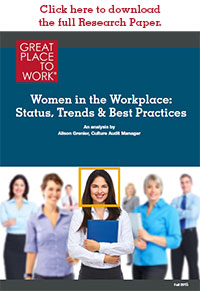 A diverse and inclusive workforce fosters innovation and collaboration, strategic imperatives in the 21st century. But despite decades of progress, Canadian women are still struggling to find true equality in the workplace in terms of opportunity, leadership and pay. This is a global phenomenon.
A diverse and inclusive workforce fosters innovation and collaboration, strategic imperatives in the 21st century. But despite decades of progress, Canadian women are still struggling to find true equality in the workplace in terms of opportunity, leadership and pay. This is a global phenomenon.
 Research and consulting firm, Great Place to Work® (GPTW) conducts the world’s largest annual workplace survey; the results of which are featured every year as Fortune’s list of 100 Best Companies (USA) and the Globe & Mail’s list of 100 Best Workplaces (Canada). Using data from this same global survey, GPTW publishes similar lists in 45 countries on six continents every year. The study represents over 10 million employees’ voices.
Research and consulting firm, Great Place to Work® (GPTW) conducts the world’s largest annual workplace survey; the results of which are featured every year as Fortune’s list of 100 Best Companies (USA) and the Globe & Mail’s list of 100 Best Workplaces (Canada). Using data from this same global survey, GPTW publishes similar lists in 45 countries on six continents every year. The study represents over 10 million employees’ voices.
Survey data suggests an ongoing dichotomy in the working experience between men and women worldwide. However, it is also clear that efforts at the Best Workplaces to mitigate this issue are having a positive (and measurable) impact.
Below, we share more information about the specific steps these leading companies are taking to level the playing field and eliminate the stereotypes and subtle, systemic inequities facing women in the workplace.
“We thought flexibility – telling people they can work anywhere, anytime - would be the answer. Then we realized that is the corporate stuff, but we are still dealing with societal issues, which need to change if we are to really move forward. We have to figure out how we can help women be successful in both places.” Delta Emerson, President, Global Shared Services, Ryan.
WORKPLACE GENDER GAPS – CHALLENGES AND STRATEGIES
1. Recruiting and Hiring Women
Women make up almost half of the Canadian workforce, but male dominated industries still struggle to find qualified female candidates. The Best Workplaces ‘think outside the box’ to ensure they are attracting and hiring the best woman for the job.
- You can’t change what you don’t measure. While quota systems are often counter-productive, setting targets for female hires can produce measurable results.
- Shout it from the roof tops. Women want to work for companies that are committed to equality for women, so develop a clear diversity strategy - and broadcast it.
- Hook them while they’re young. Encourage girls to stay interested in STEM courses by presenting exciting career options.
“If we encourage more girls to take STEM courses in high school and university, they will see that a career in technology can be a viable option for them.” Janet Kennedy, President, Microsoft Canada.
2. Women’s Career and Professional Development
Despite being well represented in the workplace and better educated than their male counterparts Canadian women hold just over 30% of senior management positions.1 The Best Workplaces acknowledge this imbalance and make specific efforts to develop their women into leaders.
- Leadership training. Specifically designed programs help women hone their leadership skills, gain credentials and build confidence to take on leadership roles.
- Learn from each other. Peer coaching networks help women make strategic contacts, practice crucial leadership behaviors and receive guidance and feedback.
- Find a sponsor. A woman’s best chance for success is to find a sponsor (male or female) who believes in them, and will advocate for them when they’re not in the room.
“Women expect that their performance will ensure they get recognized. Men are much more likely to have a sponsor or champion, someone who will push their agenda forward.” Cathy Pickard, HR Lead, Monsanto Canada.
3. Maternity Support
Maternity leave is the most significant career interruption facing women, and, perhaps the single greatest barrier to long-term career advancement. The Best Workplaces support women through these career breaks in ways that address their individual circumstances.
- Make maternity leave affordable. Just over half of Best Workplaces offer maternity leave top-up, sending a clear message that they value their female employees and want to support and retain them during their child-bearing years.
- Celebrate families. Unique perks such as company branded ‘onesies’ and free meal vouchers show caring and support for new parents.
- Gradual return to work. Gradual return to work and peer support eases the transition from maternity leave to working mom.
“RBC is committed to providing support mechanisms for women returning from maternity leave…with senior leaders who have gone through this life stage before sharing their experiences and support with our emerging talent and future leaders”. Meghan Seybold, Senior Manager, Diversity Leadership Initiatives, RBC
4. Parental Support
The best way for employers to help women meet the competing demands of work and family life is to make work-life balance a men’s issue too, by offering a wide range of supports, and encouraging both male and female employees to take advantage of them.
- Make parental leave affordable. Just over a quarter of Best Workplaces offer parental leave top up, demonstrating support for both moms and dads in meeting their parenting responsibilities.
- Lead by example. When your CEO leaves early to pick up a sick child, this sets the tone for the rest of the organization.
- When the kids are sick – Offering ‘family sick days’ or partnering with back-up care providers helps parents to cope when regular arrangements break down.
“At Vega, we understand that parenting isn’t just one person’s responsibility. Fathers are also encouraged to take advantage of Vega’s flexible environment - and this is role-modelled at the most senior levels.” Shiah Bazeley, HR Director, Vega, Winner of the 2015 and 2016 Best Workplaces for Women
5. Flexibility at Work
Flexibility is the new norm. It demonstrates that employers care about and trust their employees, and puts employees in control of their personal lives.
- Focus on results. A growing percentage of Best Workplaces are moving to a ‘results-only’ work environment, where employees have complete control over how, when and where the work gets done, as long as they deliver expected results.
- Trade money for time. Many families are choosing to work less (and earn less!) by having one or both parents work part-time, job share or take extended leaves of absence.
- Set boundaries. Technology has enabled us to work virtually anytime from anywhere, so it’s important to set boundaries with colleagues and clients.
“The demands of a client facing organization create a host of challenges for women as their lives become more complex, particularly as they become mothers… But clients are also human and they are reasonable, so I encourage employees to have conversations with clients around their priorities and deadlines so they can balance their work and life”. Lisa Kimmel, President, Edelman Canada
This analysis was written by Alison Grenier, Culture Audit Manager, Great Place to Work® Canada
WANT TO READ MORE?
• Click here to download the full version.
1 Catalyst. “Women in Canada Quick Take.” http://catalyst.org/knowledge/women-canada . 26 August 2015






